Welcome back to Magic Gatherings!
Last week we took another look at Shadows over Innistrad limited with an in-depth look at the set’s creature sizes and archetypes. This week I’ll be talking about limited again, but with a twist: I’m continuing my series on draft formats from years past, as Modern Flashback Drafts have returned to Magic Online. This week’s feature? The infamous Time Spiral.
Like Kamigawa, which I covered a few months ago, Time Spiral is among the most controversial sets in Magic‘s history. I’ll address that commentary again, but this time, I’ve opted to split my analysis into two parts: today, I’ll give an overview of the set for limited play, the better to help you run a few flashback drafts, and on Monday I’ll return with a discussion of the set’s design, execution, legacy, and controversy.
Mechanics
Time Spiral was pitched as the “nostalgia set,” with a heavy dose of “time matters,” in the block design tradition of its time—in the same way that “flavor” was the bedrock of Kamigawa and “artifacts” were the foundation of Mirrodin, Time Spiral was all about time. Both of Time Spiral‘s mechanics play with time and timing. (It’s the set that finally made flash a keyword, to boot.)
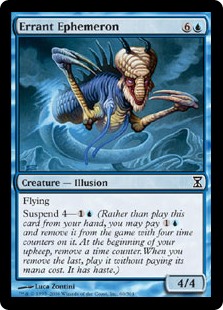
First, there’s suspend, a holdover from Saviors of Kamigawa, where it was an early contender for the slot that became the “Epic spell” mechanic. Suspend has a pretty simple conceit: instead of spending mana to play a spell, you spend time, in the form of a number of turns the spell is held in escrow until it finally resolves. Suspend has pretty nice gameplay value, once you get past the part where it’s easy to miss taking off counters in your upkeep—it lets your best creatures resolve in the middle turns, when you have mana up to protect or aid them, and it gives good value to early-turn mana, which otherwise might go to waste. It also gives both players a preview of what’s to come, which lets them make plays that are slightly more optimal, and makes both of them feel smart.
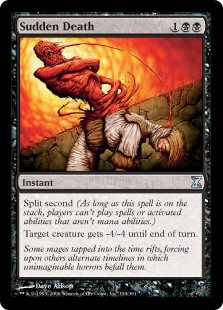
Next is split second, which honestly is a mechanic that probably didn’t need to exist. Essentially, it says “your opponent can’t counter or respond to this spell.” That’s a natural place for game design to go—players naturally want their spells to work for sure—but it’s not necessarily a good place; not being able to respond makes the game less fun for both players. Split second fronts rules that don’t really need to be fronted, and worse, obscures rules that interact with it. Did you know that paying a morph cost and turning a creature face-up is a special game action that doesn’t use the stack, so you can do it in response to a split second spell? Lots of players don’t, and the reminder text here doesn’t tell them. (This is an important aspect of Time Spiral limited, though, so make sure you remember it!)
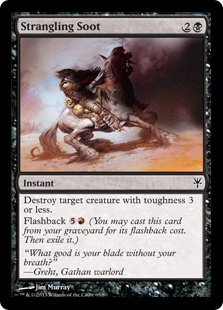
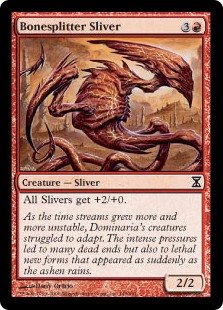
 Beyond its new mechanics, Time Spiral also brought back a host of mechanics from the game’s past—flanking, shadow, echo, madness, morph, flashback, and more. By and large, these mechanics are limited to one color or one cycle, but the aggregate presence of so much going on can be a little overwhelming. If you played with these mechanics the first time around, enjoy experiencing them again! If some of them are new, well—we’ll talk about that in a minute.
Beyond its new mechanics, Time Spiral also brought back a host of mechanics from the game’s past—flanking, shadow, echo, madness, morph, flashback, and more. By and large, these mechanics are limited to one color or one cycle, but the aggregate presence of so much going on can be a little overwhelming. If you played with these mechanics the first time around, enjoy experiencing them again! If some of them are new, well—we’ll talk about that in a minute.
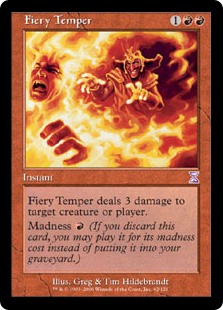

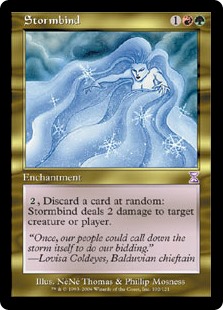 Finally, Time Spiral also features a subset of 121 “timeshifted” cards—straight reprints of older Magic cards, old border and everything. They come one per pack, and you can pick them just like any other card. I’ll have more to say about the legacy of the timeshifted sheet next article, but for now, be aware that some of the cards interact well with the set’s mechanics, and others ([mtg_card]Stormbind[/mtg_card]) are just great limited cards.
Finally, Time Spiral also features a subset of 121 “timeshifted” cards—straight reprints of older Magic cards, old border and everything. They come one per pack, and you can pick them just like any other card. I’ll have more to say about the legacy of the timeshifted sheet next article, but for now, be aware that some of the cards interact well with the set’s mechanics, and others ([mtg_card]Stormbind[/mtg_card]) are just great limited cards.
Creature Sizing
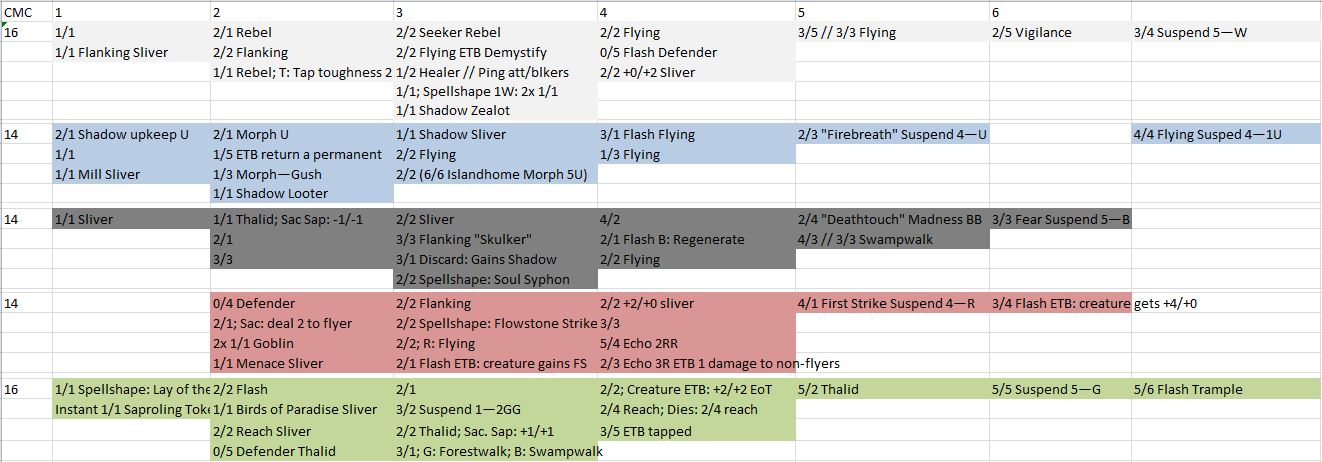
As with Kamigawa, the average creature size is a little smaller than it is in modern sets. There’s a lot of creatures in the 2/2 range, but fewer sneak up into 2/3 and 3/2 than you’d see in something like Shadows over Innistrad. Consequently, games will take a little longer, and evasion is more important. Four toughness makes for a good blocker, and five toughness is distinctly difficult to get through; there are some four- and five-power attackers, but many come with drawbacks, or only come online in later turns.
One-toughness creatures are in an interesting place in this format. There are a few ways to punish them ([mtg_card]D’Avenant Healer[/mtg_card], [mtg_card]Deathspore Thalid[/mtg_card], [mtg_card]Grapeshot[/mtg_card], [mtg_card]Flowstone Channeler[/mtg_card], [mtg_card]Subterranean Shambler[/mtg_card], Saprolings, flankers). On the other hand, none of those cards are really top picks. For the most part, they’re not too risky, but keep some of the countermeasures in mind to bring in from your sideboard if you play an opponent with multiple [mtg_card]Looter il-Kor[/mtg_card] or [mtg_card]Crookclaw Transmuter[/mtg_card]s.
Colors and Key Cards
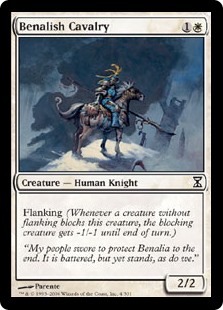
- White: First up, be careful to note that flanking, one of white’s characteristic mechanics in Time Spiral, only cares when something blocks your flanker. When your flanker blocks, nothing special happens. That said, it’s a useful way for your creatures to trade up, and pushes around X/1 creatures. White’s best commons include [mtg_card]Temporal Isolation[/mtg_card], [mtg_card]Castle Raptors[/mtg_card], and [mtg_card]Amrou Scout[/mtg_card]. Pay attention to creatures that are Rebels, which you can fetch with the latter. I have always liked [mtg_card]Amrou Seekers[/mtg_card]—most things that can block it will have to trade. White’s uncommons are pretty stacked; [mtg_card]Griffin Guide[/mtg_card] and [mtg_card]Outrider en-Kor[/mtg_card] are standouts, but they’re all pretty good save [mtg_card]Plated Pegasus[/mtg_card] and [mtg_card]Pull from Eternity[/mtg_card].
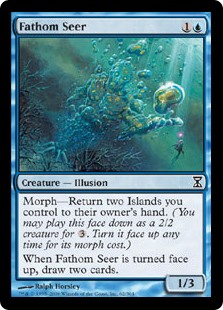
- Blue: Blue gets morph. With such a low density, you can sometimes forget that morphs play face-down as a 2/2 for 3, which is a reasonable rate in this set. There’s plenty of play to them, too; something like [mtg_card]Coral Trickster[/mtg_card] is fine on its front half, but you’re really hoping [mtg_card]Fathom Seer[/mtg_card] will be a late drop to help you refuel. Don’t be fooled by [mtg_card]Drifter il-Dal[/mtg_card]. Playing this on turn one is the equivalent of blowing up your own land. [mtg_card]Errant Ephemeron[/mtg_card] is probably the best blue creature, even though it looks unexciting. [mtg_card]Looter il-Kor[/mtg_card] and [mtg_card]Crookclaw Transmuter[/mtg_card] are also great. The latter can target itself, so you can flash it in to pick off a 2/1 attacker.
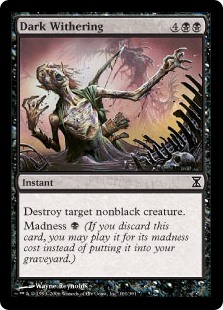
- Black: Black has madness, so everyone who’s drafted Shadows over Innistrad should feel right at home. Be sure to pick up discard outlets: [mtg_card]Trespasser il-Vec[/mtg_card] is a decent one, but spellshapers in other colors will do the trick too. (In black, there’s [mtg_card]Urborg Syphon-Mage[/mtg_card], which is legitimate win condition for a slower deck.) Black gets very nice removal and solid blockers in [mtg_card]Gorgon Recluse[/mtg_card] and [mtg_card]Cyclopean Giant[/mtg_card] (which trades with most creatures). [mtg_card]Corpulent Corpse[/mtg_card] is a good win condition, and [mtg_card]Mindstab[/mtg_card] puts opponents in a fair bind: play spells, and risk pitching the rest of your hand when [mtg_card]Mindstab[/mtg_card] resolves, or do nothing, and fall behind. At uncommon, [mtg_card]Nightshade Assassin[/mtg_card] joins the common [mtg_card]Tendrils of Corruption[/mtg_card] as a great reason to be mono-black. [mtg_card]Evil Eye of Urborg[/mtg_card] is pretty tough to block, though its attacking restriction means your opponent might be able to chump for a while.
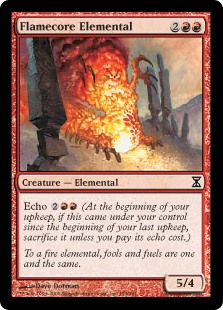
- Red: Red’s weaker than the other colors. It gets echo to itself, which isn’t anything to get excited about, although [mtg_card]Flamecore Elemental[/mtg_card] is quite large for the format. At uncommon, watch for [mtg_card]Thick-Skinned Goblin[/mtg_card], though make sure you actively choose to pay 0: the Magic Online interface isn’t the best here. Red’s got good removal in [mtg_card]Lightning Axe[/mtg_card] and [mtg_card]Rift Bolt[/mtg_card], but its creatures are a bit weak outside of [mtg_card]Keldon Halberdier[/mtg_card]. [mtg_card]Bonesplitter Sliver[/mtg_card] can end games quickly, but remember it will give the bonus to your opponent’s slivers too. Between [mtg_card]Coal Stoker[/mtg_card] and suspend, there’s a bit of a storm theme. At uncommon, [mtg_card]Undying Rage[/mtg_card] is a meaningful size upgrade, and [mtg_card]Sulfurous Blast[/mtg_card] and [mtg_card]Firemaw Kavu[/mtg_card] are among the best uncommons in the set.
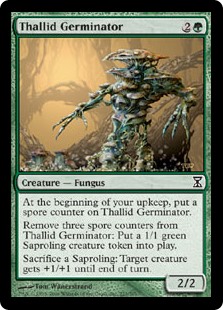
- Green: As in Kamigawa, green is mostly trading on the size of its creatures, like [mtg_card]Durkwood Baloth[/mtg_card] and [mtg_card]Havenwood Wurm[/mtg_card]. The latter is very expensive, but green also offers [mtg_card]Gemhide Sliver[/mtg_card] as an excellent “mana elf” to ramp—don’t confuse it for a “Slivers only” card. [mtg_card]Mwonvuli Acid-Moss[/mtg_card] can be a big swing if you power it out early. [mtg_card]Penumbra Spider[/mtg_card] represents a lot to punch through. Meanwhile, the Thalid deck can also be good, and you don’t even necessarily need [mtg_card]Sporesower Thalid[/mtg_card] to kick it off. Once you’re on that plan, [mtg_card]Strength in Numbers[/mtg_card] starts looking attractive. [mtg_card]Tromp the Domains[/mtg_card], at uncommon, is always good. [mtg_card]Herd Gnarr[/mtg_card] is a pretty subtle one: as a (usually) 4/4 attacker, it’s not bad, but with enough Saproling generation or suspend, it can get very large very fast.
Archetypes
Most Time Spiral limited decks are less “archetypal” and more “a color pair with a plan.” While you draft, pay particular attention to whether your deck is shaping up as primarily aggressive or primarily defensive, and choose cards accordingly. That said, there are a few particularly prominent synergies to look out for:
- Slivers—Slivers are evenly distributed among all the colors, but it’s easiest to base a Sliver deck in green, thanks to [mtg_card]Gemhide Sliver[/mtg_card]. From there, it’s natural to pair with red, which offers the power-boosting [mtg_card]Bonesplitter Sliver[/mtg_card] and the evasive [mtg_card]Two-Headed Sliver[/mtg_card]. At uncommon, the color pair offers [mtg_card]Firewake Sliver[/mtg_card], [mtg_card]Might Sliver[/mtg_card], and [mtg_card]Fury Sliver[/mtg_card]. White Slivers are no slouches either, but they’re more easily splashed once you have Gemhide setting things up.
- Blue-Black—[mtg_card]Looter il-Kor[/mtg_card] sets up madness well, and the colors share [mtg_card]Mystical Teachings[/mtg_card]. It’s is surprisingly castable in a dedicated control deck, and has a host of good targets—[mtg_card]Dark Withering[/mtg_card], [mtg_card]Careful Consideration[/mtg_card], [mtg_card]Cancel[/mtg_card], [mtg_card]Think Twice[/mtg_card], and more. Black’s heavy discard suite does a lot to help take control of the game.
- Black-Red—Drawn together by [mtg_card]Strangling Soot[/mtg_card], black and red run their traditional “kill everything” game here, made better by the larger than average number of good attackers ([mtg_card]Flamecore Elemental[/mtg_card], [mtg_card]Tectonic Fiend[/mtg_card], [mtg_card]Evil Eye of Urborg[/mtg_card]) that end the game quickly when your opponent runs out of resources.
- Thallids—Slow down the game, and eventually overwhelm your opponent with Saproling tokens—hopefully backed by [mtg_card]Tromp the Domains[/mtg_card]. This deck really only needs to be green, but black is a natural pairing, thanks to [mtg_card]Deathspore Thallid[/mtg_card] and the rare [mtg_card]Thelon of Havenwood[/mtg_card]. With [mtg_card]Fortify[/mtg_card], white can also make use of having lots of bodies.
As you might have already guessed from those descriptions, though, there’s no rigid plan you’re locked into. Much more important is picking cards that work well together, and building an overall plan for your deck. As I mentioned above, Time Spiral has lots of mechanics running around, which gives the set a Cube-like feel. (It’s no accident that Modern Masters sets have tapped into Time Spiral mechanics and archetypes like Rebels, Thallids, and suspend.) Moreover, the set has a high number of playable cards, and more still that are sometimes unplayable, but occasionally great. Be on the lookout for cards to combine in novel ways, and be willing to experiment.
That’s all for this article! I definitely recommend giving Time Spiral draft a try—it’s a fun format, if one that’s sometimes dense. I’ll be back Monday to talk about the set’s lasting reputation in that regard.
In the meantime, if you need a little more limited guidance, check out these Star City articles by yesteryear limited expert Jeroen Remie. Good luck! And may time be ever on your side.

One comment